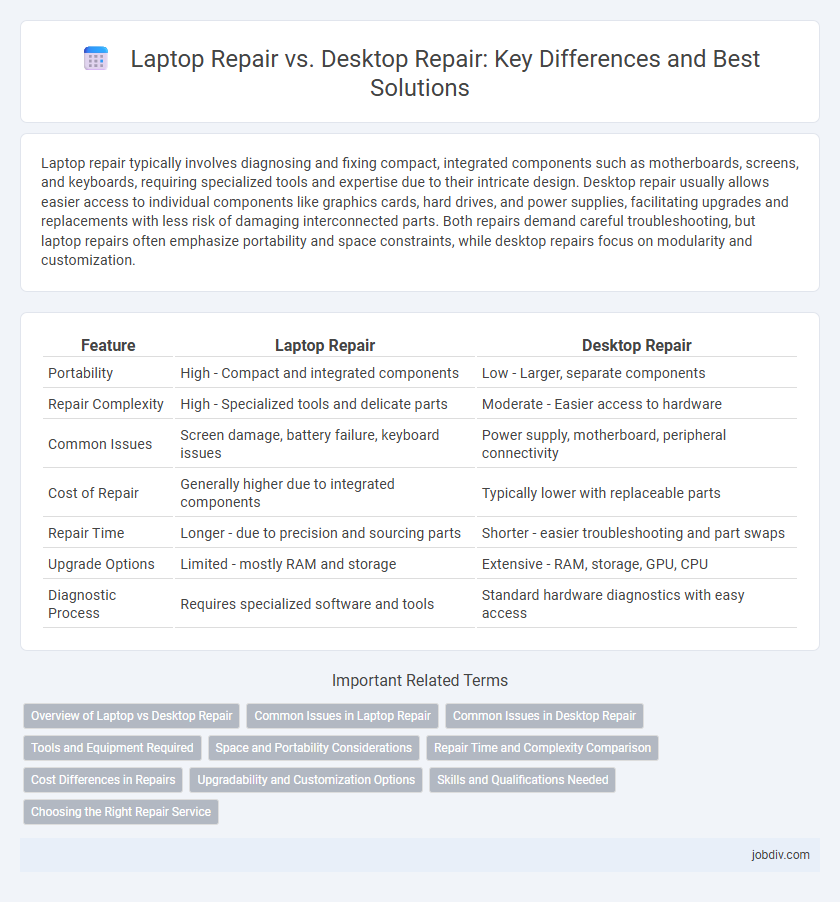Laptop repair typically involves diagnosing and fixing compact, integrated components such as motherboards, screens, and keyboards, requiring specialized tools and expertise due to their intricate design. Desktop repair usually allows easier access to individual components like graphics cards, hard drives, and power supplies, facilitating upgrades and replacements with less risk of damaging interconnected parts. Both repairs demand careful troubleshooting, but laptop repairs often emphasize portability and space constraints, while desktop repairs focus on modularity and customization.
Table of Comparison
| Feature | Laptop Repair | Desktop Repair |
|---|---|---|
| Portability | High - Compact and integrated components | Low - Larger, separate components |
| Repair Complexity | High - Specialized tools and delicate parts | Moderate - Easier access to hardware |
| Common Issues | Screen damage, battery failure, keyboard issues | Power supply, motherboard, peripheral connectivity |
| Cost of Repair | Generally higher due to integrated components | Typically lower with replaceable parts |
| Repair Time | Longer - due to precision and sourcing parts | Shorter - easier troubleshooting and part swaps |
| Upgrade Options | Limited - mostly RAM and storage | Extensive - RAM, storage, GPU, CPU |
| Diagnostic Process | Requires specialized software and tools | Standard hardware diagnostics with easy access |
Overview of Laptop vs Desktop Repair
Laptop repair typically involves compact, integrated components that require specialized tools and expertise to address issues like screen replacement or keyboard malfunctions. Desktop repair offers easier access to individual parts such as the motherboard, power supply, and graphics card, making upgrades and component swaps more straightforward. Both require diagnostic skills, but laptops demand precision due to their intricate assembly and limited space.
Common Issues in Laptop Repair
Laptop repair frequently involves common issues such as screen damage, battery failure, and overheating problems, which differ from desktop repairs that often focus on component upgrades and hardware malfunctions. Laptops also face keyboard malfunctions and hinge failures due to portable use, requiring specialized tools and techniques for disassembly. Addressing these common laptop problems demands expertise in compact circuitry and integrated components to restore functionality efficiently.
Common Issues in Desktop Repair
Common issues in desktop repair often include hardware malfunctions such as faulty power supplies, overheating due to dust accumulation, and hard drive failures. Desktop systems are more prone to component wear and connectivity problems because of their modular design and frequent upgrades. Addressing these issues requires diagnostic testing of individual parts, ensuring proper airflow, and checking internal connections to restore optimal performance.
Tools and Equipment Required
Laptop repair demands specialized tools such as precision screwdrivers, anti-static wrist straps, and spudgers to handle delicate components like miniaturized screws and fragile connectors. Desktop repair generally requires standard screwdrivers, pliers, and cable testers due to its larger, modular parts that are easier to access and replace. Investing in an electrostatic discharge (ESD) mat and thermal paste is essential for both laptop and desktop repairs to ensure component safety and optimal cooling performance.
Space and Portability Considerations
Laptop repair prioritizes compact components and space-efficient designs, making it essential to address issues in confined hardware layouts. Desktop repair allows for easier access to larger parts and flexible upgrades due to spacious internal configurations. Portability demands in laptops increase the complexity of repairs, while desktops benefit from stationary setups facilitating straightforward maintenance.
Repair Time and Complexity Comparison
Laptop repair often requires more time and expertise due to compact, integrated components and limited accessibility compared to desktops. Desktops generally allow quicker repairs with modular parts and easier access to hardware, reducing complexity. Repair time for laptops can extend by 30-50% because of intricate disassembly and specialized tools needed.
Cost Differences in Repairs
Laptop repair often incurs higher costs compared to desktop repair due to the complexity of components and limited space, which requires specialized tools and expertise. Desktop repairs benefit from modular designs and easily accessible parts, reducing labor time and part replacement expenses. Common laptop repairs, such as screen replacement and keyboard fixing, typically cost 20-40% more than analogous desktop repairs.
Upgradability and Customization Options
Laptop repair often involves limited upgradability and customization due to compact design and integrated components, making tasks like upgrading RAM or storage more challenging. Desktop repair offers greater flexibility with easy access to internal parts, allowing extensive upgrades of GPUs, CPUs, and memory for tailored performance improvements. Choosing desktops can significantly enhance customization options, while laptops prioritize portability over hardware adaptability.
Skills and Qualifications Needed
Laptop repair requires technicians to have expertise in handling compact and delicate components, advanced soldering skills, and familiarity with various laptop models and operating systems. Desktop repair professionals often need strong knowledge of assembling and troubleshooting customizable hardware, including motherboards, power supplies, and peripherals, with an emphasis on diagnostic software tools. Both roles demand proficiency in hardware diagnostics, software troubleshooting, and staying updated on the latest technology trends to ensure effective repairs.
Choosing the Right Repair Service
Choosing the right repair service depends on the device type, as laptop repair often requires specialized skills for compact hardware and delicate components like screens and keyboards. Desktop repair generally involves easier access to internal parts such as motherboards, power supplies, and drives, making it more straightforward for general technicians. Evaluating the complexity of the issue and the technician's expertise with specific device models ensures efficient and reliable repair outcomes.
Laptop Repair vs Desktop Repair Infographic

 jobdiv.com
jobdiv.com